 |
| Atmospheric Windows |
One important practical consequence of the interaction of electromagnetic radiation with matter and of the detailed composition of our atmosphere is that only light in certain wavelength regions can penetrate the atmosphere well. These regions are called atmospheric windows.
The following figure shows the amount of absorption at different wavelengths in the atmosphere. It is presented in terms of the half-absorption altitude, which is defined to be the altitude in the atmosphere (measured from the Earth's surface) where 1/2 of the radiation of a given wavelength incident on the upper atmosphere has been absorbed. Windows correspond to those regions where the half-absorption altitude is very small.
 |
The dominant windows in the atmosphere are seen to be in the visible and radio frequency regions, while X-Rays and UV are seen to be very strongly absorbed and Gamma Rays and IR are somewhat less strongly absorbed. We see clearly the argument for getting above the atmosphere with detectors on space-borne platforms in order to observe at wavelengths other than the visible and RF regions.